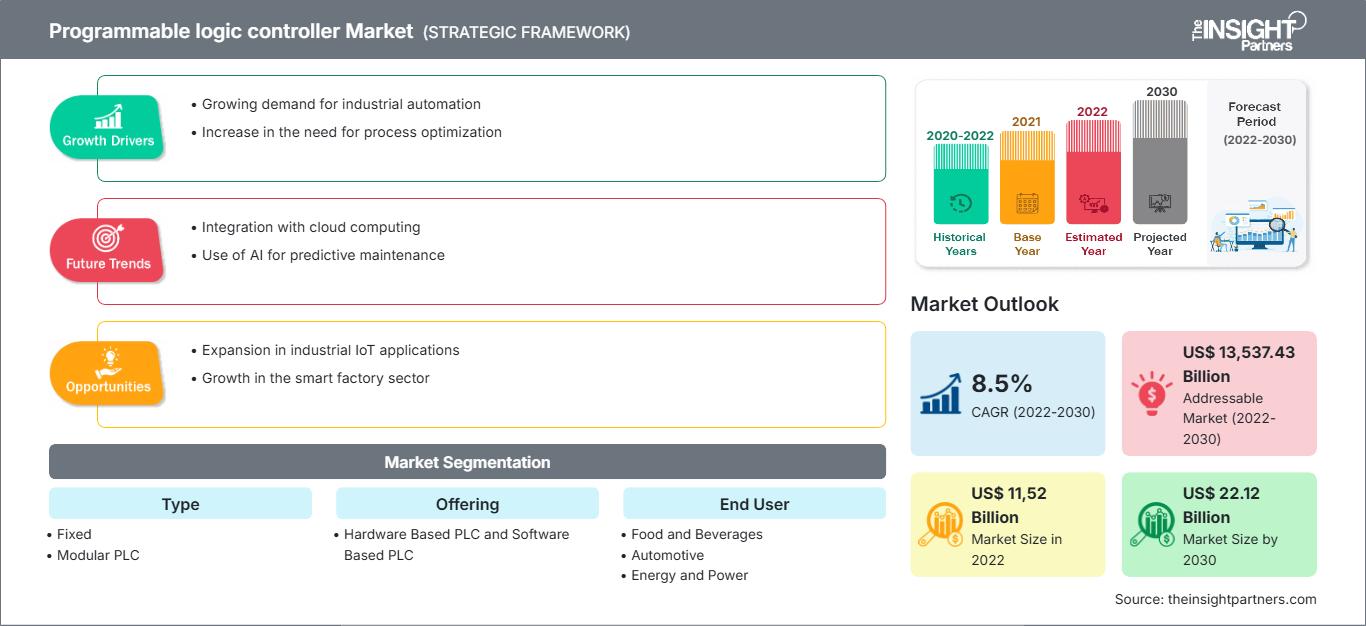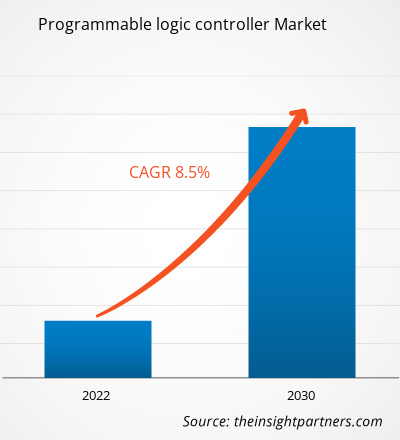[Forschungsbericht] Der Markt für speicherprogrammierbare Steuerungen soll von 11,52 Milliarden US-Dollar im Jahr 2022 auf 22,12 Milliarden US-Dollar im Jahr 2030 wachsen; von 2022 bis 2030 wird ein durchschnittliches jährliches Wachstum von 8,5 % erwartet.
Analystenperspektive:
In den letzten Jahren hat die industrielle Automatisierung im globalen Industriesektor stark zugenommen. Speicherprogrammierbare Steuerungen (SPS) sind elektronische Geräte, die für Aufgaben wie Überwachung und Steuerung programmiert sind. SPS-basierte Automatisierung bietet gegenüber älteren industriellen Automatisierungssystemen verschiedene Vorteile. Produkte auf dem Markt für speicherprogrammierbare Steuerungen sind effizienter und gleichzeitig weniger wartungsintensiv als frühere Technologien. Darüber hinaus sind sie flexibler und funktionaler als frühere Systeme und daher gut für die sich ständig ändernden Anforderungen des modernen Industriesektors geeignet. Mit dem wachsenden Bewusstsein für die Vorteile von Produkten aus dem Markt für speicherprogrammierbare Steuerungen (SPS) dürfte deren Verbreitung in den kommenden Jahren zunehmen. Ein Produkt im Markt für speicherprogrammierbare Steuerungen (SPS) ist ein Computer, der für die Überwachung und Steuerung einer Vielzahl industrieller Prozesse entwickelt wurde – von einfachen Maschinen bis hin zu komplexen Produktionslinien. Diese Steuerungen können an Sensor- und Steuerungsnetzwerke angebunden werden und so autonom oder in Zusammenarbeit mit anderen Geräten arbeiten. Daher sind Produkte aus dem Markt für speicherprogrammierbare Steuerungen (SPS) entscheidend für den reibungslosen und effizienten Betrieb industrieller Automatisierungssysteme.
Gut geplante Produktions- und Marketingprozesse sind die Voraussetzung für Hersteller, um eine „intelligente Fabrik“ aufzubauen. Diese vereinfacht die Steuerung des Produktionsprozesses, eliminiert manuelle Eingriffe in die Produktionslinie, ermöglicht die rechtzeitige Erfassung korrekter Produktionsliniendaten und verbessert die Produktionsplanung. Zu den verschiedenen auf dem Markt erhältlichen digitalen und analogen Steuergeräten gehören SPSen, die unter anderem den Start und Stopp eines Motors, das Öffnen und Schließen von Magnetventilen, die Produktzählung sowie die Regelung und Einstellung von Temperatur, Druck und Durchfluss steuern. Produkte auf dem Markt für speicherprogrammierbare Steuerungen finden heute breite Anwendung in Branchen wie Stahl, Erdöl, Chemie, Elektrizität, Baustoffe, Maschinenbau, Automobil, Textil, Transport, Umweltschutz sowie Kultur und Unterhaltung. So kündigte Siemens im Juni 2023 die Einführung einer vollständig virtuellen SPS an. Die Simatic S7-1500V erweitert das bestehende Simatic-Angebot und unterstützt gleichzeitig die virtuelle SPS-Berechnung.
Marktübersicht für speicherprogrammierbare Steuerungen:
Der Einsatz speicherprogrammierbarer Steuerungen (SPS) in der industriellen Automatisierung wird voraussichtlich zunehmen und sich verändern, da sich die Industriezweige in Richtung Industrie 4.0 und dem industriellen Internet der Dinge (IIoT) bewegen. Produkte auf dem Markt wurden in der Vergangenheit als eigenständige Geräte eingesetzt. Aufgrund des zunehmenden Trends zur Konnektivität können diese Systeme nun jedoch mithilfe von Ethernet und anderen Netzwerkprotokollen mit anderen Geräten und Systemen kommunizieren. Dies ermöglicht den Datenaustausch in Echtzeit sowie die Fernüberwachung und -steuerung. Die Integration von SPS in andere industrielle Steuerungssysteme gewinnt an Popularität, da Unternehmen versuchen, Prozesse zu rationalisieren und die Effizienz zu steigern.
Die Reichweite industrieller Steuerungs- und Automatisierungstechnologien geht über den Fertigungssektor hinaus. So lieferte ABB im März 2021 Automatisierungssysteme für Solarkraftwerke mit einer Leistung von 5 Gigatonnen (GW) in Indien mithilfe speicherprogrammierbarer Steuerungen. Das SCADA-System von ABB, eine Automatisierungslösung, unterstützt den Betrieb von Solarprojektanlagen, indem es Anlagenbetreibern ermöglicht, Projektdaten von einem einzigen Standort aus zu überwachen und zu analysieren.
Passen Sie diesen Bericht Ihren Anforderungen an
Sie erhalten kostenlos Anpassungen an jedem Bericht, einschließlich Teilen dieses Berichts oder einer Analyse auf Länderebene, eines Excel-Datenpakets sowie tolle Angebote und Rabatte für Start-ups und Universitäten.
Markt für speicherprogrammierbare Steuerungen: Strategische Einblicke

- Holen Sie sich die wichtigsten Markttrends aus diesem Bericht.Dieses KOSTENLOSE Beispiel umfasst Datenanalysen, die von Markttrends bis hin zu Schätzungen und Prognosen reichen.
Sie erhalten kostenlos Anpassungen an jedem Bericht, einschließlich Teilen dieses Berichts oder einer Analyse auf Länderebene, eines Excel-Datenpakets sowie tolle Angebote und Rabatte für Start-ups und Universitäten.
Markt für speicherprogrammierbare Steuerungen: Strategische Einblicke

- Holen Sie sich die wichtigsten Markttrends aus diesem Bericht.Dieses KOSTENLOSE Beispiel umfasst Datenanalysen, die von Markttrends bis hin zu Schätzungen und Prognosen reichen.
Markttreiber für speicherprogrammierbare Steuerungen:
Die zunehmende Rolle von SPS in Industrie 4.0 treibt das Wachstum des Marktes für speicherprogrammierbare Steuerungen voran
Technologische Fortschritte wie künstliche Intelligenz, Cloud Computing, fortschrittliche Sensoren und Big Data Analytics haben weiterhin erhebliche Auswirkungen auf die Umgebungen in Industriezweigen. Diese Durchbrüche in der Industrietechnologie werden umgangssprachlich als Industrie 4.0 bezeichnet. SPS spielen in der neuen industriellen Welt eine wichtige Rolle als primäre Steuerung, Eingabezentrale und Schnittstelle für menschliche Bediener. Die SPS-Technologie wird ständig weiterentwickelt, um eine bessere Konnektivität mit vielen Eingangssensoren über das industrielle Internet der Dinge (IIoT) zu ermöglichen. Dadurch können sie als Kernprozessor in Echtzeit-Fertigungsvorgängen fungieren. Dadurch können SPS nun problemlos riesige Datenmengen erfassen und an maschinelle Lernsysteme weitergeben. Daten von Eingangssensoren und anderen Geräten können beispielsweise mit SPS-Daten kombiniert werden, um das „große Ganze“ zu veranschaulichen, das sich aus den „Big Data“ ergibt. Werksleiter und Datenanalysten können dann Analysetools einsetzen, um Big Data besser zu verfolgen, Ressourcen optimal zu nutzen, Logistik durchzuführen, Aufträge zu planen und Aufgaben wie die Zeiteinteilung von Lieferanten zu planen, um hocheffiziente Fertigungsprozesse zu entwickeln. Darüber hinaus können „Big Data“ verfolgt und ausgewertet werden, um die Leistung von Maschinen und Geräten zu optimieren und die vorbeugende Wartung innerhalb industrieller Systeme zu ermöglichen.
SPS haben zusammen mit anderen wichtigen Komponenten, die die Maschinenschnittstelle und Prozessautomatisierung ermöglichen, in den letzten Jahren eine wesentliche Rolle bei der Digitalisierung der Fertigung gespielt. Sie werden im Zuge der Industrie 4.0-Revolution voraussichtlich auch als primäre Steuerung, Eingabezentrale und Mensch-Maschine-Schnittstelle (HMI) für Arbeiter eine bedeutende Rolle spielen. Die intelligenten Fabriken der Zukunft werden voraussichtlich durch die Kombination von SPS, Automatisierung und Robotik florieren. Somit fördert die zunehmende Rolle von SPS in der Industrie 4.0 das Wachstum des Marktes für speicherprogrammierbare Steuerungen.
Marktsegmentanalyse für speicherprogrammierbare Steuerungen:
Basierend auf dem Angebot ist der Markt für speicherprogrammierbare Steuerungen in hardwarebasierte und softwarebasierte SPS unterteilt. SPS bilden das Rückgrat von Steuerungssystemen in der industriellen Automatisierung und ermöglichen eine effiziente Überwachung und Steuerung von Prozessen. Sie bestehen aus Hardware- und Softwarekomponenten, die zusammenarbeiten. In industriellen Umgebungen ersetzt eine Softwarekomponente zunehmend eine gleichwertige Hardwarekomponente. Softwarebasierte speicherprogrammierbare Steuerungen (Soft-SPS) sind zuverlässig, leistungsstark und anpassungsfähig. Im September 2017 gab 3S-Smart Software Solutions, Entwickler der herstellerunabhängigen Automatisierungssoftware Codesys IEC 61131-3, bekannt, dass seine SoftPLC-Software jetzt als Laufzeitumgebung für offene Linux-basierte Steuerungssysteme wie Wagos PFC 100 und Siemens Simatic IOT2000 verfügbar ist.
Regionale Marktanalyse für speicherprogrammierbare Steuerungen:
Nordamerika, insbesondere die USA, dominiert aufgrund des technologischen Fortschritts den Sektor der industriellen Automatisierung. Die USA sind ein weltweit bekanntes Industriezentrum mit florierenden Branchen wie der Automobil-, Chemie-, Lebensmittel- und Getränke- sowie der Öl- und Gasindustrie. Dies sind einige der wichtigsten Endverbraucher von speicherprogrammierbaren Steuerungssystemen. Die USA sind einer der weltweit größten Automobilmärkte. Der Absatz von leichten Fahrzeugen im Land wurde im Jahr 2020 auf 14,5 Millionen Einheiten geschätzt. In Bezug auf Autoabsatz und -produktion sind die USA der zweitgrößte Markt der Welt. Laut Autos Drive America werden ausländische Hersteller bis 2020 fünf Millionen Fahrzeuge in den USA produzieren.
Die Chemiebranche in den USA verarbeitet Rohstoffe zu über 70.000 Gütern, die für das moderne Leben notwendig sind, und deckt den Bedarf von über 750.000 Endverbrauchern im ganzen Land. Zahlreiche Chemieunternehmen im Land – von Petrochemieherstellern bis hin zu Chemiegroßhändlern – verwenden, produzieren, lagern, transportieren oder liefern Chemikalien über eine komplexe globale Lieferkette. Die enorme Präsenz und operative Reichweite verschiedener Branchen schafft daher eine Nachfrage nach speicherprogrammierbaren Steuerungen in den USA.
Speicherprogrammierbare SteuerungRegionale Einblicke in den Markt für speicherprogrammierbare Steuerungen
Regionale Einblicke in den Markt für speicherprogrammierbare Steuerungen
Die Analysten von The Insight Partners haben die regionalen Trends und Faktoren, die den Markt für speicherprogrammierbare Steuerungen im Prognosezeitraum beeinflussen, ausführlich erläutert. In diesem Abschnitt werden auch die Marktsegmente und die geografische Lage in Nordamerika, Europa, im asiatisch-pazifischen Raum, im Nahen Osten und Afrika sowie in Süd- und Mittelamerika erörtert.
Umfang des Marktberichts zu speicherprogrammierbaren Steuerungen
| Berichtsattribut | Einzelheiten |
|---|---|
| Marktgröße in 2022 | US$ 11,52 Billion |
| Marktgröße nach 2030 | US$ 22.12 Billion |
| Globale CAGR (2022 - 2030) | 8.5% |
| Historische Daten | 2020-2022 |
| Prognosezeitraum | 2022-2030 |
| Abgedeckte Segmente |
By Typ
|
| Abgedeckte Regionen und Länder | Nordamerika
|
| Marktführer und wichtige Unternehmensprofile |
|
Dichte der Marktteilnehmer für speicherprogrammierbare Steuerungen: Verständnis ihrer Auswirkungen auf die Geschäftsdynamik
Der Markt für speicherprogrammierbare Steuerungen wächst rasant. Die steigende Nachfrage der Endverbraucher ist auf Faktoren wie veränderte Verbraucherpräferenzen, technologische Fortschritte und ein stärkeres Bewusstsein für die Produktvorteile zurückzuführen. Mit der steigenden Nachfrage erweitern Unternehmen ihr Angebot, entwickeln Innovationen, um den Bedürfnissen der Verbraucher gerecht zu werden, und nutzen neue Trends, was das Marktwachstum weiter ankurbelt.

- Holen Sie sich die Markt für speicherprogrammierbare Steuerungen Übersicht der wichtigsten Akteure
Analyse der wichtigsten Akteure auf dem Markt für speicherprogrammierbare Steuerungen:
Die Analyse des Marktes für speicherprogrammierbare Steuerungen umfasst die Profilerstellung von Unternehmen wie Siemens, Rockwell Automation, Mitsubishi Electric Corporation, OMRON Corporation, Schneider Electric, ABB, Eaton, Honeywell International Inc., Emerson Electric Co. und Hitachi, Ltd.
Neueste Entwicklungen auf dem Markt für speicherprogrammierbare Steuerungen:
Anorganische und organische Strategien wie Fusionen und Übernahmen werden von den Unternehmen auf dem Markt stark übernommen. Einige der wichtigsten Entwicklungen der letzten Zeit sind unten aufgeführt.
- Im April 2023 stellte Siemens auf der Hannover Messe 2023 eine komplette virtuelle SPS vor. Die Simatic S7-1500V erweitert das bestehende Simatic-Angebot und erfüllt gleichzeitig spezifische Marktanforderungen, wie z. B. virtuelles SPS-Computing.
- Im September 2019 kündigte Siemens die Veröffentlichung eines Moduls an, das KI-Funktionen in die Simatic S7-1500-Steuerung und das ET 200MP-E/A-System des Unternehmens integriert. Siemens stellte das Angebot dieses Jahr auf der PACK EXPO in Las Vegas in den USA vor und legte damit den Grundstein für ein zukünftiges Portfolio, das KI auf allen Ebenen der Totally Integrated Automation (TIA)-Architektur von Siemens ermöglicht, einer Kombination aus Hardware und Software, die alles nahtlos miteinander verbindet.
- Historische Analyse (2 Jahre), Basisjahr, Prognose (7 Jahre) mit CAGR
- PEST- und SWOT-Analyse
- Marktgröße Wert/Volumen – Global, Regional, Land
- Branchen- und Wettbewerbslandschaft
- Excel-Datensatz
Aktuelle Berichte
Erfahrungsberichte
Grund zum Kauf
- Fundierte Entscheidungsfindung
- Marktdynamik verstehen
- Wettbewerbsanalyse
- Kundeneinblicke
- Marktprognosen
- Risikominimierung
- Strategische Planung
- Investitionsbegründung
- Identifizierung neuer Märkte
- Verbesserung von Marketingstrategien
- Steigerung der Betriebseffizienz
- Anpassung an regulatorische Trends






















 Kostenlose Probe anfordern für - Markt für speicherprogrammierbare Steuerungen
Kostenlose Probe anfordern für - Markt für speicherprogrammierbare Steuerungen